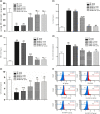Potential Protective Effects of the Water-Soluble Chinese Propolis on Hypertension Induced by High-Salt Intake
- PMID: 32112504
- PMCID: PMC7938408
- DOI: 10.1111/cts.12770
Potential Protective Effects of the Water-Soluble Chinese Propolis on Hypertension Induced by High-Salt Intake
Abstract
High-salt (HS) intake is closely associated with the ignition and progression of hypertension. The mechanisms might be involved in endothelial dysfunction, nitric oxide deficiency, oxidative stress, and proinflammatory cytokines. Propolis is widely used as a natural antioxidant and is a well-known functional food for its biological activities, which includes anti-inflammation, antimicrobial, and liver detoxification. In this study, we successfully replicated a HS diet-induced hypertensive rat model. We found that in the long-term HS diet group, the myocardial function of the rats was altered and led to a significant decrease (around 49%) in heart function. However, doses of Chinese water-soluble propolis (WSP) were found directly proportional (11%, 60%, 91%, respectively) to the myocardial function improvement in hypertensive rats. The results from the blood circulation test and hematoxylin-eosin stains showed that propolis had protective effects on myocardial functions and blood vessels in hypertensive rats. Also, based on the results of western blot and polymerase chain reaction, WSP effectively regulated Nox2 and Nox4 levels and was responsible for a decrease in reactive oxygen species synthesis. Our findings demonstrate that Chinese WSP has a significant effect on the blood pressure of hypertensive rats and their cardiovascular functions that improved significantly. The improvement in the cardiovascular functions might be related to the process of anti-oxidation, anti-inflammation, and the improvements of the endothelial function in hypertensive rats.
© 2020 The Authors. Clinical and Translational Science published by Wiley Periodicals, Inc. on behalf of the American Society for Clinical Pharmacology and Therapeutics.
Conflict of interest statement
The authors declared no competing interests for this work.
Figures





Similar articles
-
Protective effect of Xin-Ji-Er-Kang on cardiovascular remodeling in high-salt induced hypertensive mice: Role ofoxidative stress and endothelial dysfunction.Biomed Pharmacother. 2019 Jul;115:108937. doi: 10.1016/j.biopha.2019.108937. Epub 2019 May 9. Biomed Pharmacother. 2019. PMID: 31078040
-
Effects of Xin-Ji-Er-Kang formula on 2K1C-induced hypertension and cardiovascular remodeling in rats.J Ethnopharmacol. 2014 Sep 11;155(2):1227-35. doi: 10.1016/j.jep.2014.07.006. Epub 2014 Jul 23. J Ethnopharmacol. 2014. PMID: 25063306
-
Dietary iron restriction prevents hypertensive cardiovascular remodeling in Dahl salt-sensitive rats.Hypertension. 2011 Mar;57(3):497-504. doi: 10.1161/HYPERTENSIONAHA.110.159681. Epub 2011 Jan 24. Hypertension. 2011. PMID: 21263124
-
Salt-dependent hypertension and inflammation: targeting the gut-brain axis and the immune system with Brazilian green propolis.Inflammopharmacology. 2020 Oct;28(5):1163-1182. doi: 10.1007/s10787-020-00742-2. Epub 2020 Aug 12. Inflammopharmacology. 2020. PMID: 32785827 Free PMC article. Review.
-
Impact of Salt Intake on the Pathogenesis and Treatment of Hypertension.Adv Exp Med Biol. 2017;956:61-84. doi: 10.1007/5584_2016_147. Adv Exp Med Biol. 2017. PMID: 27757935 Review.
Cited by
-
Propolis and its constituents against cardiovascular risk factors including obesity, hypertension, atherosclerosis, diabetes, and dyslipidemia: A comprehensive review.Iran J Basic Med Sci. 2023;26(8):853-871. doi: 10.22038/IJBMS.2023.67793.14835. Iran J Basic Med Sci. 2023. PMID: 37427329 Free PMC article. Review.
-
The Cardiovascular Therapeutic Potential of Propolis-A Comprehensive Review.Biology (Basel). 2021 Jan 4;10(1):27. doi: 10.3390/biology10010027. Biology (Basel). 2021. PMID: 33406745 Free PMC article. Review.
-
Propolis in Metabolic Syndrome and Its Associated Chronic Diseases: A Narrative Review.Antioxidants (Basel). 2021 Feb 26;10(3):348. doi: 10.3390/antiox10030348. Antioxidants (Basel). 2021. PMID: 33652692 Free PMC article. Review.
-
The effects of propolis on pro-oxidant-antioxidant balance, glycemic control, and quality of life in chronic kidney disease: a randomized, double-blind, placebo-controlled trial.Sci Rep. 2023 Jun 19;13(1):9884. doi: 10.1038/s41598-023-37033-z. Sci Rep. 2023. PMID: 37337027 Free PMC article. Clinical Trial.
-
Propolis and its potential against SARS-CoV-2 infection mechanisms and COVID-19 disease: Running title: Propolis against SARS-CoV-2 infection and COVID-19.Biomed Pharmacother. 2020 Nov;131:110622. doi: 10.1016/j.biopha.2020.110622. Epub 2020 Aug 17. Biomed Pharmacother. 2020. PMID: 32890967 Free PMC article. Review.
References
-
- Kendig, M.D. & Morris, M.J. Reviewing the effects of dietary salt on cognition: mechanisms and future directions. Asia Pac. J. Clin. Nutr. 28, 6–14 (2019). - PubMed
-
- Takashima, M. , Ichihara, K. & Hirata, Y. Neuroprotective effects of Brazilian green propolis on oxytosis/ferroptosis in mouse hippocampal HT22 cells. Food Chem. Toxicol. 132, 110669 (2019). - PubMed
Publication types
MeSH terms
Substances
LinkOut - more resources
Full Text Sources
Medical
Miscellaneous

